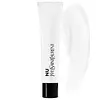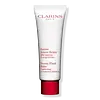What's inside
What's inside
 Key Ingredients
Key Ingredients

 Benefits
Benefits

 Concerns
Concerns

 Ingredients Side-by-side
Ingredients Side-by-side

Water
Skin ConditioningGlycerin
HumectantDicaprylyl Ether
EmollientCaprylic/Capric Triglyceride
MaskingPentylene Glycol
Skin ConditioningJojoba Esters
EmollientPropanediol
SolventCetyl Esters
EmollientCoco-Caprylate/Caprate
EmollientPolyglyceryl-6 Distearate
EmulsifyingButyrospermum Parkii Butter
Skin ConditioningBehenyl Alcohol
EmollientPelargonium Graveolens Extract
MaskingAcacia Decurrens Flower Cera
EmollientGlycine Soja Oil
EmollientZingiber Officinale Root Extract
MaskingSanguisorba Officinalis Root Extract
CleansingHelianthus Annuus Seed Cera
EmollientHelianthus Annuus Seed Oil
EmollientHaematococcus Pluvialis Extract
AntioxidantCinnamomum Cassia Bark Extract
MaskingTin Oxide
AbrasiveSorbitan Oleate
EmulsifyingIsohexadecane
EmollientSodium Hyaluronate
HumectantSodium Stearoyl Glutamate
CleansingSilica Silylate
EmollientHydrolyzed Opuntia Ficus-Indica Flower Extract
AbrasiveHydroxypropyl Starch Phosphate
Capryloyl Salicylic Acid
ExfoliatingCitric Acid
BufferingTrisodium Ethylenediamine Disuccinate
Synthetic Fluorphlogopite
Ethylhexylglycerin
Skin ConditioningPolyglycerin-3
HumectantPolyglyceryl-3 Beeswax
EmulsifyingPolysorbate 80
EmulsifyingAcrylamide/Sodium Acryloyldimethyltaurate Copolymer
Emulsion StabilisingCetyl Alcohol
EmollientButylene Glycol
HumectantTocopherol
AntioxidantPhenoxyethanol
PreservativeCI 77491
Cosmetic ColorantCI 77891
Cosmetic ColorantParfum
MaskingWater, Glycerin, Dicaprylyl Ether, Caprylic/Capric Triglyceride, Pentylene Glycol, Jojoba Esters, Propanediol, Cetyl Esters, Coco-Caprylate/Caprate, Polyglyceryl-6 Distearate, Butyrospermum Parkii Butter, Behenyl Alcohol, Pelargonium Graveolens Extract, Acacia Decurrens Flower Cera, Glycine Soja Oil, Zingiber Officinale Root Extract, Sanguisorba Officinalis Root Extract, Helianthus Annuus Seed Cera, Helianthus Annuus Seed Oil, Haematococcus Pluvialis Extract, Cinnamomum Cassia Bark Extract, Tin Oxide, Sorbitan Oleate, Isohexadecane, Sodium Hyaluronate, Sodium Stearoyl Glutamate, Silica Silylate, Hydrolyzed Opuntia Ficus-Indica Flower Extract, Hydroxypropyl Starch Phosphate, Capryloyl Salicylic Acid, Citric Acid, Trisodium Ethylenediamine Disuccinate, Synthetic Fluorphlogopite, Ethylhexylglycerin, Polyglycerin-3, Polyglyceryl-3 Beeswax, Polysorbate 80, Acrylamide/Sodium Acryloyldimethyltaurate Copolymer, Cetyl Alcohol, Butylene Glycol, Tocopherol, Phenoxyethanol, CI 77491, CI 77891, Parfum
Water
Skin ConditioningCaprylic/Capric Triglyceride
MaskingGlycerin
HumectantButyrospermum Parkii Butter
Skin ConditioningPropanediol
SolventC15-19 Alkane
SolventSilica Silylate
EmollientAmmonium Acryloyldimethyltaurate/Vp Copolymer
Sorbitan Stearate
EmulsifyingPolyacrylate Crosspolymer-6
Emulsion StabilisingButylene Glycol
HumectantHydroxyacetophenone
AntioxidantParfum
MaskingAvena Sativa Kernel Extract
AbrasiveEthylhexylglycerin
Skin ConditioningTocopheryl Acetate
AntioxidantAloe Barbadensis Leaf Juice Powder
Skin ConditioningDisodium EDTA
Sucrose Cocoate
EmulsifyingHydrolyzed Opuntia Ficus-Indica Flower Extract
AbrasiveSodium Hydroxide
BufferingMarrubium Vulgare Extract
Skin ConditioningSodium Benzoate
MaskingT-Butyl Alcohol
Perfuming1,2-Hexanediol
Skin ConditioningCaprylyl Glycol
EmollientMalpighia Emarginata Seed Extract
Skin ConditioningPhenethyl Alcohol
MaskingCapsicum Annuum Fruit Extract
AntimicrobialFurcellaria Lumbricalis Extract
Skin ConditioningCI 14700
Cosmetic ColorantLapsana Communis Flower/Leaf/Stem Extract
Skin ConditioningMaris Sal
Skin ConditioningHelianthus Annuus Seed Oil
EmollientTocopherol
AntioxidantRosmarinus Officinalis Leaf Extract
AntimicrobialWater, Caprylic/Capric Triglyceride, Glycerin, Butyrospermum Parkii Butter, Propanediol, C15-19 Alkane, Silica Silylate, Ammonium Acryloyldimethyltaurate/Vp Copolymer, Sorbitan Stearate, Polyacrylate Crosspolymer-6, Butylene Glycol, Hydroxyacetophenone, Parfum, Avena Sativa Kernel Extract, Ethylhexylglycerin, Tocopheryl Acetate, Aloe Barbadensis Leaf Juice Powder, Disodium EDTA, Sucrose Cocoate, Hydrolyzed Opuntia Ficus-Indica Flower Extract, Sodium Hydroxide, Marrubium Vulgare Extract, Sodium Benzoate, T-Butyl Alcohol, 1,2-Hexanediol, Caprylyl Glycol, Malpighia Emarginata Seed Extract, Phenethyl Alcohol, Capsicum Annuum Fruit Extract, Furcellaria Lumbricalis Extract, CI 14700, Lapsana Communis Flower/Leaf/Stem Extract, Maris Sal, Helianthus Annuus Seed Oil, Tocopherol, Rosmarinus Officinalis Leaf Extract
Ingredients Explained
These ingredients are found in both products.
Ingredients higher up in an ingredient list are typically present in a larger amount.
Butylene Glycol (or BG) is used within cosmetic products for a few different reasons:
Overall, Butylene Glycol is a safe and well-rounded ingredient that works well with other ingredients.
Though this ingredient works well with most skin types, some people with sensitive skin may experience a reaction such as allergic rashes, closed comedones, or itchiness.
Learn more about Butylene GlycolThis ingredient is also known as shea butter. It is an effective skin hydrator and emollient.
Emollients help soothe and soften your skin. It does this by creating a protective film on your skin. This barrier helps trap moisture and keeps your skin hydrated. Emollients may be effective at treating dry or itchy skin.
Shea butter is rich in antioxidants. Antioxidants help fight free-radicals, or molecules that may harm the body. It is also full of fatty acids including stearic acid and linoleic acid. These acids help replenish the skin and keep skin moisturized.
While Shea Butter has an SPF rating of about 3-4, it is not a sunscreen replacement.
Shea butter may not be fungal acne safe. We recommend speaking with a professional if you have any concerns.
Learn more about Butyrospermum Parkii ButterThis ingredient is an emollient, solvent, and texture enhancer. It is considered a skin-softener by helping the skin prevent moisture loss.
It helps thicken a product's formula and makes it easier to spread by dissolving clumping compounds.
Caprylic Triglyceride is made by combining glycerin with coconut oil, forming a clear liquid.
While there is an assumption Caprylic Triglyceride can clog pores due to it being derived from coconut oil, there is no research supporting this.
Learn more about Caprylic/Capric TriglycerideEthylhexylglycerin (we can't pronounce this either) is commonly used as a preservative and skin softener. It is derived from glyceryl.
You might see Ethylhexylglycerin often paired with other preservatives such as phenoxyethanol. Ethylhexylglycerin has been found to increase the effectiveness of these other preservatives.
Glycerin is already naturally found in your skin. It helps moisturize and protect your skin.
A study from 2016 found glycerin to be more effective as a humectant than AHAs and hyaluronic acid.
As a humectant, it helps the skin stay hydrated by pulling moisture to your skin. The low molecular weight of glycerin allows it to pull moisture into the deeper layers of your skin.
Hydrated skin improves your skin barrier; Your skin barrier helps protect against irritants and bacteria.
Glycerin has also been found to have antimicrobial and antiviral properties. Due to these properties, glycerin is often used in wound and burn treatments.
In cosmetics, glycerin is usually derived from plants such as soybean or palm. However, it can also be sourced from animals, such as tallow or animal fat.
This ingredient is organic, colorless, odorless, and non-toxic.
Glycerin is the name for this ingredient in American English. British English uses Glycerol/Glycerine.
Learn more about GlycerinHelianthus Annuus Seed Oil is the oil derived from the seeds of a Sunflower. Sunflower seed oil is non-fragrant. It is an emollient, meaning it helps to soften the skin.
Sunflower seed oil contains many fatty acids. The fatty acids found in sunflower seeds include (from highest amount to least): linoleic acid, myristic acid, palmitic acid, stearic acid, arachidic acid, oleic acid, and linolenic acid.
These fatty acids help the skin create ceramides. Ceramides play a role in repairing the skin barrier.
Helianthus Annuus Seed Oil helps moisturize the skin. This in turn helps the skin look more rejuvenated and smoother.
Sunflowers are rich in vitamin E.
Historians believe Indigenous cultures of North America domesticated sunflowers before corn. Thus they relied on sunflower oil for a variety of uses. One such use is moisturizing skin and hair.
Sunflower seed oil may not be fungal acne safe. We recommend speaking with a professional if you have any concerns.
Learn more about Helianthus Annuus Seed OilHydrolyzed Opuntia Ficus-Indica Flower Extract is an exfoliant.
Parfum is a catch-all term for an ingredient or more that is used to give a scent to products.
Also called "fragrance", this ingredient can be a blend of hundreds of chemicals or plant oils. This means every product with "fragrance" or "parfum" in the ingredients list is a different mixture.
For instance, Habanolide is a proprietary trade name for a specific aroma chemical. When used as a fragrance ingredient in cosmetics, most aroma chemicals fall under the broad labeling category of “FRAGRANCE” or “PARFUM” according to EU and US regulations.
The term 'parfum' or 'fragrance' is not regulated in many countries. In many cases, it is up to the brand to define this term.
For instance, many brands choose to label themselves as "fragrance-free" because they are not using synthetic fragrances. However, their products may still contain ingredients such as essential oils that are considered a fragrance by INCI standards.
One example is Calendula flower extract. Calendula is an essential oil that still imparts a scent or 'fragrance'.
Depending on the blend, the ingredients in the mixture can cause allergies and sensitivities on the skin. Some ingredients that are known EU allergens include linalool and citronellol.
Parfum can also be used to mask or cover an unpleasant scent.
The bottom line is: not all fragrances/parfum/ingredients are created equally. If you are worried about fragrances, we recommend taking a closer look at an ingredient. And of course, we always recommend speaking with a professional.
Learn more about ParfumPropanediol is an all-star ingredient. It softens, hydrates, and smooths the skin.
It’s often used to:
Propanediol is not likely to cause sensitivity and considered safe to use. It is derived from corn or petroleum with a clear color and no scent.
Learn more about PropanediolSilica Silylate is a siloxane polymer, meaning it is made up of silicon and oxygen atoms. It is not soluble in water.
This ingredient is a white powder with oil-absorbing, emollient, and anticaking properties.
Tocopherol (also known as Vitamin E) is a common antioxidant used to help protect the skin from free-radicals and strengthen the skin barrier. It's also fat soluble - this means our skin is great at absorbing it.
Vitamin E also helps keep your natural skin lipids healthy. Your lipid skin barrier naturally consists of lipids, ceramides, and fatty acids. Vitamin E offers extra protection for your skin’s lipid barrier, keeping your skin healthy and nourished.
Another benefit is a bit of UV protection. Vitamin E helps reduce the damage caused by UVB rays. (It should not replace your sunscreen). Combining it with Vitamin C can decrease sunburned cells and hyperpigmentation after UV exposure.
You might have noticed Vitamin E + C often paired together. This is because it is great at stabilizing Vitamin C. Using the two together helps increase the effectiveness of both ingredients.
There are often claims that Vitamin E can reduce/prevent scarring, but these claims haven't been confirmed by scientific research.
Learn more about TocopherolWater. It's the most common cosmetic ingredient of all. You'll usually see it at the top of ingredient lists, meaning that it makes up the largest part of the product.
So why is it so popular? Water most often acts as a solvent - this means that it helps dissolve other ingredients into the formulation.
You'll also recognize water as that liquid we all need to stay alive. If you see this, drink a glass of water. Stay hydrated!
Learn more about Water